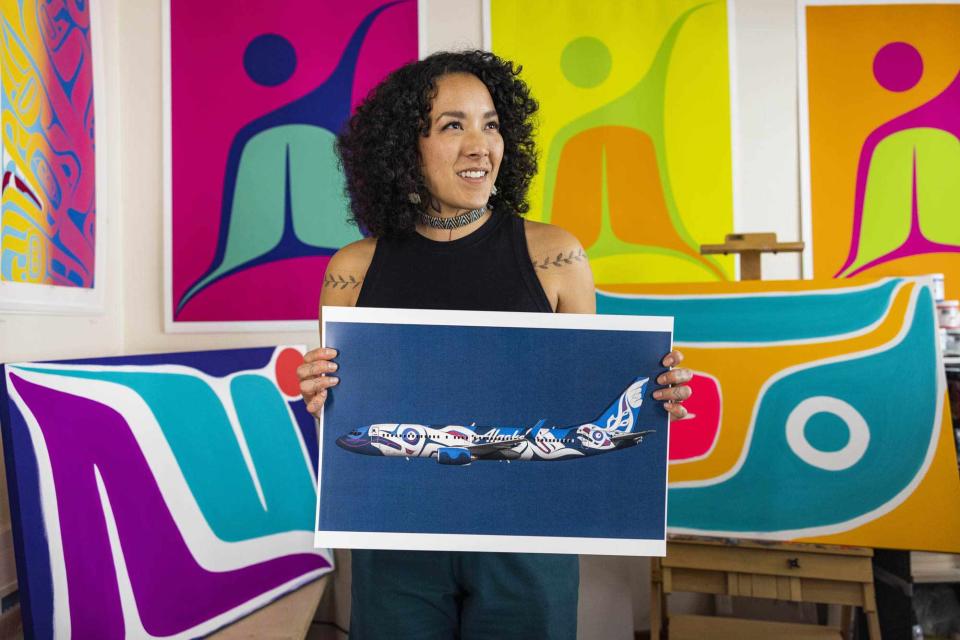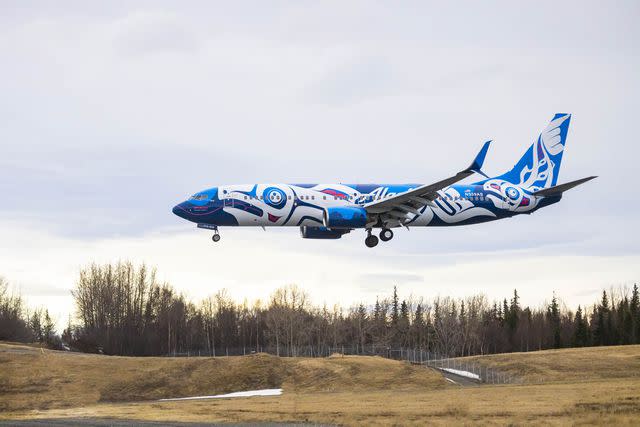How This New Alaska Airlines Plane Is Celebrating the State's Indigenous Culture With a 2,000-year-old Art Style
It makes a statement about climate change and Indigenous issues.

Courtesy of Alaska Airlines
Alaska Airlines is debuting a new Boeing 737-800 plane livery on May 12 featuring formline artwork — an Indigenous art style dating back more than 2,000 years.
The plane, designed by Indigenous artist Crystal Worl, depicts a male and female sockeye salmon in broad white strokes, accented with red and blue, on a two-toned blue background. “You're probably familiar with seeing [formline] on canoes, totem poles, long house fronts, and a lot of our regalia,” Worl told Travel + Leisure about the artwork.
The door reads “Xáat Kwáani,” which is Alaskan Tlingit for “Salmon People.” (The Tlingit are Indigenous peoples of North America's Pacific Northwest with a presence in southeastern Alaska.)
Alaska Airlines is the first U.S. carrier to feature Tlingit language on an airplane. (Though, it's not its first salmon-centric aircraft — the carrier had a plane with a custom-painted Alaska king salmon in its fleet until recently.)

Courtesy of Alaska Airlines
The art style is typically two-dimensional, hallmarked by one or two curving lines crescendoing through the art piece and diminishing down to the other side. It uses three main colors — red, black, and blue-green — and primarily sticks to broad U-shaped, S-shaped, and egg-shaped strokes.
Formline is also clan-specific and a culturally responsible art form, meaning you can’t just draw whatever you want. So if you want to draw something claimed by another clan — like salmon, which Worl’s clan claims — you should ask permission first.
Though the style is thousands of years old, it didn’t actually have a name until 1965. “We had to manufacture a word in Tlingit for 'art' and for 'artwork' and for 'artists' — because those words didn’t really exist, because everything that was made was made with things on it,” Xh’unei Lance Twitchell, a professor of Alaska Native Languages and a Tlingit formline artist, told Juneau Empire in 2018.
Worl incorporates formline into much of her artwork, featured on everything from prints and murals to basketball courts and ambulances. The design for the plane, though, started with something much smaller: an Instagram post.
In 2020, Worl downloaded a template of a Boeing 737 and superimposed her artwork on it. She posted it on Instagram and tagged Alaska Airlines. Creating artwork for an Alaska Airlines plane had been a vision of Worl’s for years, as her family and friends had long worked for the carrier. (Her mom even cofounded the airline’s Native Employee Network, a resource group providing social and networking opportunities to its native employees.)
Three years after the Instagram post, Alaska Airlines' regional vice president Marilyn Romano was looking to hire an Alaskan artist to design a plane. She compiled a list, but couldn’t decide who to pick ... and then an issue of Alaska Business Magazine landed on her desk with Worl on the cover. Romano decided that Worl was the best artist for the job.

Courtesy of Alaska Airlines
Jonny Mack, Alaska Airlines' creative director, adapted Worl’s artwork for the plane. It is painted on the aircraft rather than applied with a decal, which makes it longer lasting. The airline expects the artwork to remain in flight for about 10 years.
Featuring salmon was a deliberate and symbolic choice. Salmon — along with other types of fish, humans, animals, and supernatural beings — has a strong presence in formline art. For Worl, it was important to honor and bring awareness to the salmon with her design — especially because Alaska is experiencing something of a salmon drought at the moment.
Worl's family has gone to fish camps for generations. (Adult salmon spend one to four years in the ocean before returning to their freshwater origins to spawn. Indigenous communities catch salmon during this migration.) But over the past two years, little to no salmon have returned — mainly due to overfishing and climate change. It’s devastating for the native communities that rely on storing salmon for year-round food supply.
Worl hopes her art can help people understand what’s happening with the salmon and learn how to help. It’s also a way to spread awareness about Indigenous culture.
“As Indigenous people, we don't view ourselves as different from animals,” Worl said. “We're one of the same. If you look at our regalia and our clans, we identify as animals. I'm the sockeye salmon. [Salmon has] provided us this livelihood, this abundance of life and nutrients and energy that they bring to us and the environment and the animals that we also live off of. The relationship should be reciprocal.”
For more Travel & Leisure news, make sure to sign up for our newsletter!
Read the original article on Travel & Leisure.

